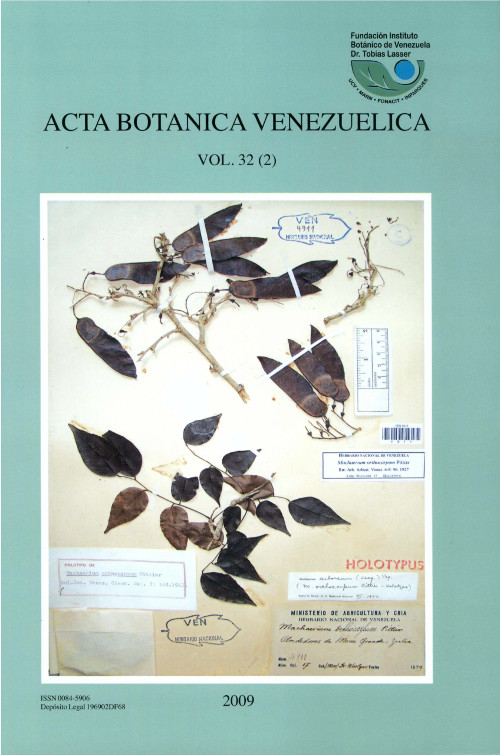CORRELACIONES ENTRE LA FENOLOGÍA REPRODUCTIVA DE LA VEGETACIÓN Y VARIABLES CLIMÁTICAS EN LOS ALTOS LLANOS CENTRALES VENEZOLANOS
Resumen
RESUMEN
La floración, producción de frutos inmaduros y de frutos maduros fueron evaluadaspara 171 especies pertenecientes a 57 familias de angiospermas presentes en la vegetaciónde la Estación Biológica de los Llanos. El objetivo de este estudio fue establecer la correlaciónentre la fenología reproductiva y seis variables climáticas de acuerdo a la forma devida, hábitat y a nivel comunitario. Los valores mensuales de precipitación y humedad relativaestán positivamente correlacionados, y los valores mensuales de evaporación y temperaturaestán negativamente correlacionados con el número de lianas, hierbas perennes yhierbas anuales con flores, mientras que lo contrario fue encontrado para el número de árbolescon flores. El número de especies con flores está negativamente correlacionado con latemperatura y la evaporación, y positivamente correlacionado con la humedad relativa y laprecipitación para las áreas de transición bosque-sabana, sabana, área perturbada y para lacomunidad. Los valores de insolación están negativamente correlacionados con la floraciónen el bosque y en la transición bosque-sabana. Sólo la precipitación está positivamente correlacionadacon el número de especies con flores en el bosque. El número de especies confrutos inmaduros tiene correlación positiva con la humedad relativa para arbustos, hierbasperennes y hierbas anuales, y con la precipitación para arbustos y hierbas perennes. Por elcontrario, el número de especies con frutos inmaduros está negativamente correlacionadocon la radiación para árboles, temperatura para especies herbáceas, y evaporación para arbustosy especies herbáceas. El número de lianas con frutos inmaduros sólo está negativamentecorrelacionado con la temperatura. El número total de especies de plantas con frutosinmaduros está negativamente correlacionado con la temperatura y evaporación en los cuatrohábitats, y positivamente con la humedad relativa a nivel comunitario. El número de especiescon frutos inmaduros está negativamente correlacionado con la radiación y positivamentecon la precipitación en el área del bosque. El número de arbustos y hierbas perennescon frutos maduros tuvo correlación negativa con la temperatura y la evaporación, y positivacon la humedad relativa. El número de lianas con frutos maduros está negativamente correlacionadocon la humedad relativa y la precipitación, y positivamente correlacionado conla evaporación. El número de especies con frutos maduros sólo está positivamente correlacionadocon la radiación para el área de bosque. La fenología reproductiva está positivamentecorrelacionada con las variables climáticas asociadas con la disponibilidad de aguay negativamente con las variables climáticas asociadas con la deficiencia de agua. Estas correlacionessugieren que la fenología reproductiva puede covariar con atributos particularesdel clima dependiendo de la forma de vida y hábitat de la comunidad.
ABSTRACT
Flowering, unripe fruit production, and fruit maturation were evaluated for 171 speciesbelonging to 57 families of angiosperms in the vegetation of the Venezuelan CentralPlains at Estación Biológica de los Llanos. The main goal of this study was to establish thecorrelation between reproductive phenology and six climatic variables according to plantlife form, habitat, and overall community. Monthly values of precipitation and relative humidityare positively correlated, and monthly values of evaporation and temperature arenegatively correlated with the number of lianas, perennial herbs, and annual herbs, the contrarywas found for the number of tree species with flower. The number of plant species withflowers was negatively correlated with temperature and evaporation, and positively correlatedwith relative humidity and precipitation for forest-savanna transition, savanna, disturbedarea, and overall community. Insolation was negatively correlated with flowering in theforest and forest-savanna transition. Precipitation was only correlated with the number offlowering plant species in the forest. The number of species with unripe fruits was positivelycorrelated with the relative humidity for shrubs, perennial herbs, and annual herbs, and withprecipitation for shrubs and perennial herbs. On the contrary, species with unripe fruitswas negatively correlated with radiation for trees, temperature for herbaceous species, andevaporation for shrubs and herbaceous species. The number of lianas with unripe fruits wasonly correlated with temperature. The total number of species with unripe fruits was negativelycorrelated with temperature and evaporation for the four habitats, and positively correlatedwith the relative humidity at the community level. In addition, unripe fruits were negativelycorrelated with radiation and positively correlated with precipitation in the forest.Fruit maturation of shrubs and perennial herbs were negatively correlated with temperatureand evaporation, and positively correlated with relative humidity. In addition, fruit maturationof lianas were negatively correlated with relative humidity and precipitation and positivelycorrelated with evaporation. The number of plant species with ripe fruits was onlypositively correlated with radiation for the forest. In general, the reproductive phenologywas positively correlated with climatic variables related to water availability and negativelywith the climatic variables associated with water deficiency. These correlations suggest thatreproductive phenology may co-vary according to particular attributes of the climate dependingupon plant life form and the habitat of the community.
Descargas
Descargas
Número
Sección
Licencia
© Instituto Experimental Jardín Botánico "Dr. Tobías Lasser" |


